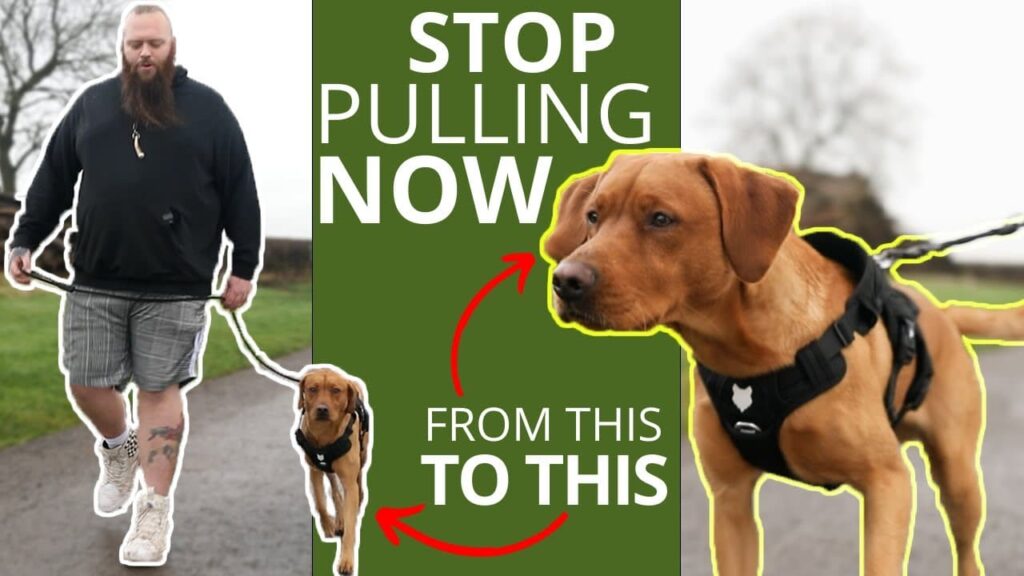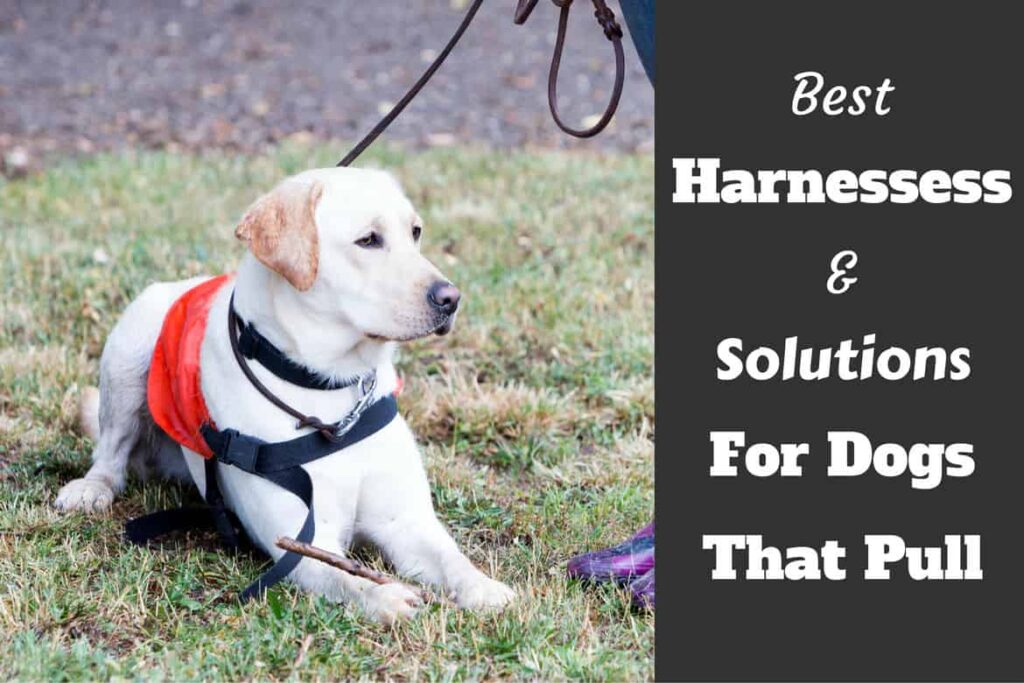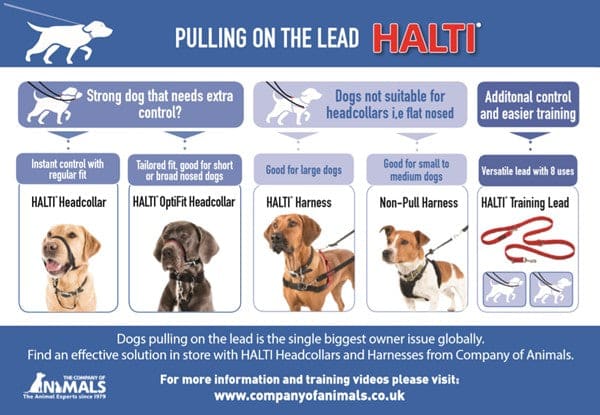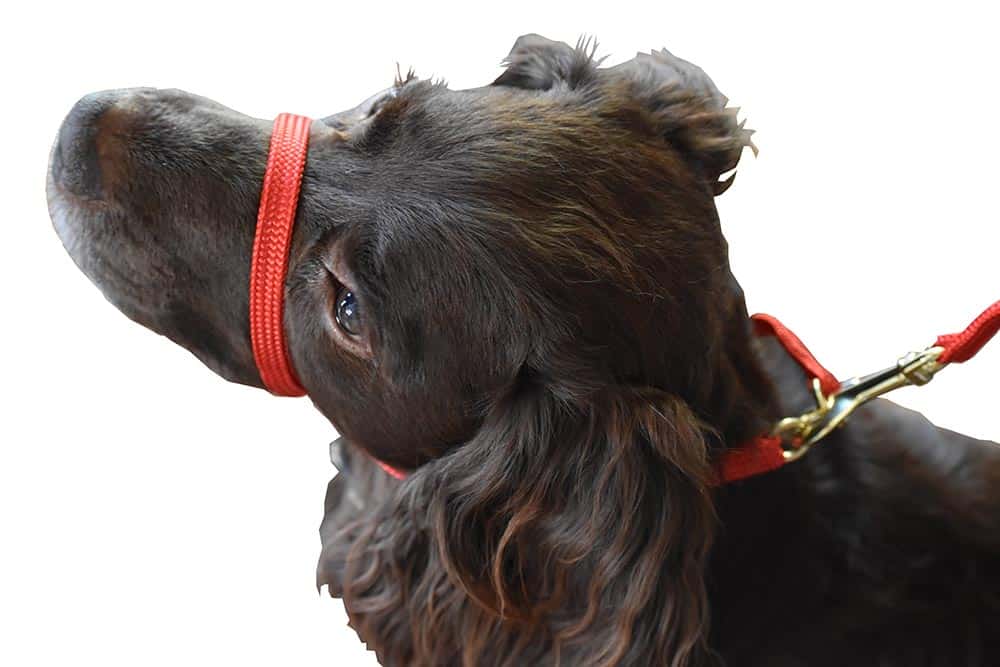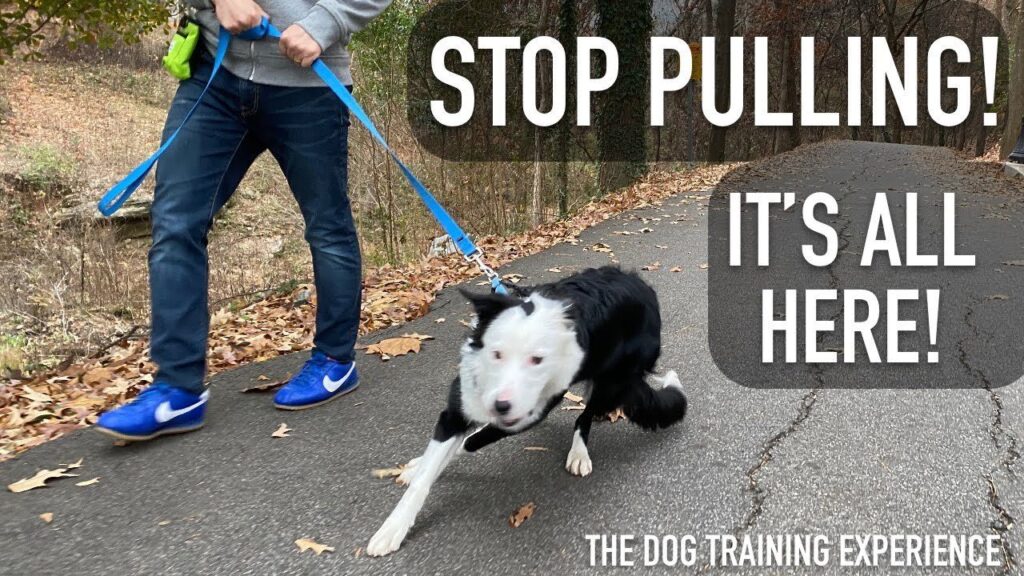Are you tired of going on walks with your dog and constantly feeling like you’re being dragged along?
We all know how frustrating it can be when a dog pulls on the leash, making the experience less enjoyable for you and your furry friend.
But fret not! This article will explore the best solutions to stop your dog’s pulling habits.
Say goodbye to those arm-wrenching walks and hello to a more pleasant and relaxed experience for you and your pup.
Harness Options
Front-Clip Harness
A front-clip harness is popular for dogs that tend to pull on the leash. This type of harness attaches the leash to a ring on the front of the chest, changing the pulling force’s direction. Instead of the dog being able to use its total body weight to pull forward, the front-clip harness redirects its momentum toward the side. This makes it easier to control and steer the dog while walking, as their pulling power is significantly reduced.
Back-Clip Harness
On the other hand, a back-clip harness attaches the leash to a ring on the back of the dog’s body. While this type of harness may not be as effective in preventing pulling as the front-clip option, it can still be a suitable choice for dogs that don’t have a strong tendency to pull. Back-clip harnesses are typically more comfortable for dogs, as they don’t pressure their chest or restrict their shoulder movement. However, it’s important to note that some dogs may still pull even with a back-clip harness so additional training may be necessary.
Head Halters
Head halters, such as the famous brand “Gentle Leader,” are another option to consider when trying to stop a dog from pulling. These devices fit over the dog’s nose and neck, giving you control over their head movements.
Similar to how a horse is controlled by a halter, a head halter allows you to guide your dog’s head in the desired direction gently. This helps to redirect their attention and ultimately discourages pulling. However, it’s important to note that head halters require proper introduction and acclimation, as some dogs may initially resist wearing them.
Training Techniques
Positive Reinforcement
Positive reinforcement is one of the most effective training techniques for stopping a dog from pulling. This method involves rewarding your dog with treats, praise, or other forms of positive reinforcement when they exhibit desired behaviors, such as walking calmly beside you without pulling.
By associating good behavior with rewards, you can motivate your dog to repeat those behaviors in the future. It’s essential to be consistent and patient when using positive reinforcement, as it may take time for your dog to entirely understand what is expected of them.
Clicker Training
Clicker training is another positive reinforcement technique that can stop a dog from pulling. This method involves using a small handheld device called a clicker to make a distinct sound whenever your dog performs the desired behavior.
The clicker’s sound is immediately followed by a treat or reward, reinforcing the connection between the behavior and the reward. Over time, your dog will associate the clicker sound with positive outcomes and will be more likely to repeat the desired behavior. Clicker training can be particularly effective in reinforcing leash manners and heel walking.
Redirecting Focus
Another technique to stop a dog from pulling is redirecting its focus. Instead of letting your dog fixate on what is ahead and pulling towards it, redirect their attention back to you. This can be done using verbal cues, such as calling their name or a command like “look.” When your dog looks at you, reward them with praise or a treat.
By consistently redirecting their focus towards you and rewarding them for paying attention, you can help reduce their desire to pull and keep their attention on you during walks.
Stop-and-Go Method
The stop-and-go method is simple yet effective for controlling a pulling dog. Whenever your dog starts to pull on the leash, stop walking. Stand still and wait for your dog to ease the tension on the leash and turn towards you.
Once they have calmed down and are walking beside you, resume walking. Stopping every time your dog pulls teaches them that pulling does not result in getting to their desired destination. This method requires patience and consistency but can be a powerful tool in teaching your dog to walk calmly beside you.
Leash Options
Standard Leash
A standard leash consists of a handle on one end and a clip or loop on the other to attach to your dog’s collar or harness. Standard leashes come in different lengths, typically 4 to 8 feet, allowing you to choose the length that suits your walking style.
This leash option provides you with direct control over your dog’s movements and allows for accessible communication during walks. Choosing a comfortable leash for you and your dog is essential and provides a secure attachment point to prevent accidental escapes.
Retractable Leash
Retractable leashes are another popular option for dog owners. These leashes consist of a handle, a thin cord or tape, and a locking mechanism to control the leash length. With a retractable leash, your dog has more freedom to explore and roam while still being connected to you.
However, it’s essential to be cautious when using a retractable leash, as the extended length can make it challenging to maintain control over your dog, especially if it tends to pull. Retractable leashes are best suited for well-trained dogs with good leash manners and impulse control.
Using Treats
Positive Association
Treats can be a powerful way to create a positive association with walking and reinforce good leash manners. Before heading out for a walk, offer your dog a treat to associate walking with something enjoyable. Throughout the walk, reward your dog with treats for exhibiting desired behaviors, such as walking calmly beside you or responding to your cues. This positive association helps motivate your dog to behave well on the leash and makes the walking experience enjoyable for both of you.
Reward-Based Training
Reward-based training involves using treats as rewards for desired behaviors. When your dog walks calmly on the leash without pulling, please give them a treat as a reward. This reinforces the idea that staying close to you and walking politely is a positive behavior that results in good things.
Gradually decrease the frequency of treat rewards as your dog becomes more consistent in their walking manners, but continue offering occasional treats to reinforce the behavior. Using high-value treats your dog finds particularly enticing to maximize their motivation is essential.
Adjusting Equipment
Proper Harness Fit
Whatever type of harness you choose, ensuring it fits your dog correctly is essential. A well-fitting harness should be snug but not too tight, allowing for comfortable movement without causing any discomfort or chafing. The harness should also distribute the pressure evenly across your dog’s body, avoiding excessive tension on their neck or shoulders.
Adjust the straps and buckles according to your dog’s size and body shape to ensure a secure and comfortable fit. If you’re unsure how to fit a harness properly, consult the manufacturer’s guidelines or seek guidance from a pet professional.
Leash Length and Positioning
When using a leash, it’s essential to consider the length and positioning to promote good leash manners. A shorter leash provides more control and helps prevent your dog from wandering too far ahead or getting into potential trouble.
Position the leash to allow your dog to walk slightly ahead of you but with slack in the leash. Avoid holding the leash too tightly, as this can create tension and discomfort for your dog. By adjusting the leash length and positioning, you can maintain better control over your dog’s movements and discourage pulling.
Professional Help
Dog Trainer
If you’re struggling to stop your dog from pulling, seeking help from a professional dog trainer can be beneficial. A dog trainer can assess the specific issues causing your dog’s pulling behavior and provide you with personalized training techniques and guidance.
They can teach you effective communication methods and work with your dog to improve their leash manners. A dog trainer can also offer support and address any other behavioral issues contributing to the pulling behavior.
Behaviorist
In some cases, a certified animal behaviorist may be necessary to address more complex behavioral issues associated with a dog’s pulling behavior. A behaviorist is an expert in animal behavior and can provide in-depth analysis and guidance based on your dog’s specific needs.
They can help identify any underlying causes of the pulling behavior, such as fear, anxiety, or aggression, and develop a specialized behavior modification plan. Working with a behaviorist ensures you receive professional assistance tailored to your dog’s circumstances.
Exercise and Mental Stimulation
Meeting Energy Needs
Ensuring that your dog’s energy needs are met is crucial in preventing excess pulling during walks. Dogs under-exercised or have pent-up energy are likelier to exhibit restless and excitable behaviors, including pulling. Be sure to provide your dog with regular opportunities for physical exercise, such as daily walks, runs, or play sessions.
The amount and intensity of exercise needed will vary depending on your dog’s breed, age, and overall health. Engaging in activities that match your dog’s energy levels can significantly reduce pulling incidents.
Engaging Playtime
In addition to physical exercise, regular playtime with your dog is essential for their mental well-being. Mental stimulation can tire out a dog just as much as physical exercise, helping to alleviate boredom and restlessness that may contribute to pulling behaviors.
Incorporate interactive toys, puzzle games, and training sessions during playtime to keep your dog mentally engaged and challenged. You can help reduce your dog’s desire to pull on the leash by providing both physical and mental stimulation.
Obedience Training
Obedience training plays a significant role in teaching a dog proper leash manners and preventing pulling. Basic commands such as “sit,” “stay,” and “heel” are essential for maintaining control and ensuring a safe and enjoyable walking experience.
By teaching your dog these commands and practicing them consistently during walks, you establish a transparent communication system that helps prevent pulling. Obedience training also strengthens the bond between you and your dog, making them more likely to listen to your cues and follow your lead.
Understanding the Cause
Fear or Anxiety
Fear or anxiety can be underlying causes of pulling behavior in dogs. Some dogs may fear certain stimuli or environments, causing them to pull on the leash to escape or avoid perceived threats. In these cases, it’s essential to address the root cause of the fear or anxiety and work on desensitization and counter-conditioning techniques.
Gradual exposure to the trigger while providing positive reinforcement can help your dog associate the once-fearful situation with positive outcomes and reduce their pulling behavior.
Excitement Levels
Some dogs naturally have high excitement levels, which can contribute to pulling behavior. They may become overly excited about walking or encountering new stimuli, causing them to pull on the leash in anticipation.
Teaching your dog impulse control through training exercises such as “wait” or “leave it” can help decrease their excitement and prevent pulling. Teaching your dog to stay calm and composed during walks can promote better leash manners and a more enjoyable walking experience.
Lack of Training
In some cases, pulling behavior stems from a lack of training or inconsistent reinforcement of leash manners. Dogs may not understand the expectations or have not been taught proper walking etiquette.
You can address the lack of training and reduce pulling incidents by training your dog to walk calmly on the leash and consistently reinforcing the desired behaviors. Consistency is vital in training, so reinforce good behavior and correct pulling consistently throughout your walks.
Consistency and Patience
Establishing Routine
Consistency is crucial when trying to stop a dog from pulling. Establishing a routine for walks and training sessions can help your dog understand the expectations and reinforce good behaviors.
Designate specific times and durations for walks, and be consistent in your training techniques and reinforcement. By following a consistent routine, your dog will learn what is expected of them and be likelier to exhibit good leash manners.
Persistent Training
Training a dog to stop pulling requires patience and persistence. Dedicating regular training sessions on leash manners is essential, even if your dog has improved. Dogs need consistent reminders and reinforcement to maintain good behavior.
Be patient and understanding with your dog; learning new behaviors takes time. Celebrate even minor improvements and continue to work consistently towards your goal of a well-behaved walking companion.
Avoiding Reinforcement of Pulling
Consistency also applies to avoiding unintentional reinforcement of pulling behavior. It’s essential to avoid inadvertently rewarding or reinforcing pulling. For example, if your dog pulls on the leash and allows it to continue moving forward, it perceives pulling as an effective way to get what it wants.
Instead, use the previously mentioned training techniques to redirect their focus or utilize the stop-and-go method to discourage pulling. By consistently addressing pulling and not allowing it to be successful, you can help break the habit and encourage better leash manners.
Health Considerations
Physical Condition
A dog’s physical condition can contribute to their pulling behavior. If your dog has not exercised regularly or is overweight, it may lack the physical stamina and muscle strength required for controlled walking.
It’s essential to ensure your dog is in good physical condition through regular exercise and a well-balanced diet. Consult your veterinarian to determine the appropriate exercise regimen for your dog’s breed, age, and overall health. You can help reduce pulling incidents and increase their overall fitness by improving their physical condition.
Pain or Discomfort
Pain or discomfort can also cause a dog to pull on the leash. Canine orthopedic issues, such as arthritis or joint problems, could make walking uncomfortable or painful. Similarly, ill-fitting equipment, such as a collar or harness that digs into the dog’s skin, can cause discomfort and lead to pulling.
Regular veterinary check-ups and properly fitting harnesses or collars can help identify and address pain or discomfort issues. Ensuring your dog is comfortable during walks promotes better leash manners and well-being.
In conclusion, stopping a dog from pulling requires selecting the right equipment, using effective training techniques, and understanding the underlying causes. Harness options such as front-clip or back-clip harnesses and head halters can help reduce pulling force and redirect focus. Positive reinforcement, clicker training, redirecting focus, and the stop-and-go method are effective training techniques to discourage pulling. Choosing a standard or retractable leash depends on the dog’s behavior and training, balancing freedom and control.
Treats can create a positive association with walking and reinforce good leash manners. Positive association involves providing treats to make walking enjoyable, while reward-based training reinforces desired behaviors with treats. Proper fitting of harnesses and adjusting leash length and positioning are essential for comfort and control. Seeking professional help from a dog trainer or behaviorist can provide personalized guidance and support.
Regular exercise and engagement in both physical and mental activities can help meet energy needs and prevent excess pulling. Understanding the cause of pulling, such as fear or anxiety, excitement levels, or lack of training, allows targeted behavior modification. Consistency and patience are crucial in setting routines, persistently training, and avoiding reinforcement of pulling. Considering the dog’s physical condition and addressing any pain or discomfort ensures a comfortable and enjoyable walking experience.
By implementing these strategies and techniques, you can effectively stop your dog from pulling and transform your walks into a pleasant experience for you and your furry companion. Remember, combining the right equipment, consistent training, and understanding your dog’s needs will create a well-behaved walking partner and strengthen the bond between you and your dog.


